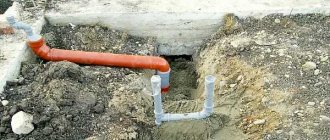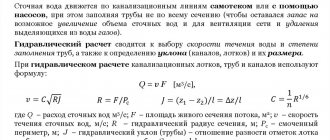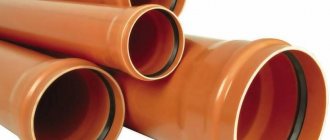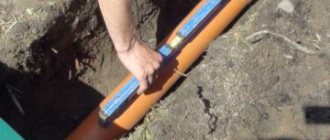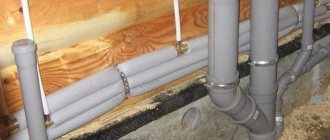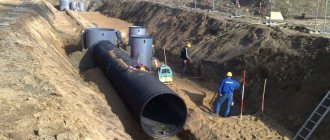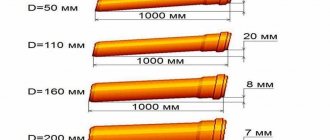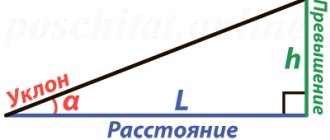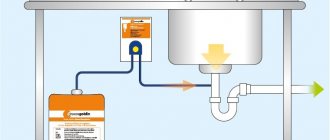Types of pipes
There are 2 main materials for making pipes: plastic and metal. The first, in turn, is divided into 3 types:
- polyvinyl chloride (PVC);
- polyethylene (PET);
- polypropylene (PP).
All of them can be easily found on the market.
The standard diameter of sewer pipes is indicated in the technical specifications and most often it ranges from 5 to 12 cm. But there are types of sewer pipes with a smaller diameter, which are also made according to technical specifications. conditions, which will facilitate their selection for different systems.
Pipes are divided into categories, depending on the highway on which they will be used (each diameter is 16 cm):
- SN-2. Such pipes are made of lightweight material, therefore they are used in areas with minimal load (domestic sewerage indoors, residential areas without traffic load).
- SN-4. They are denser than the previous ones, so they are purchased for a sewer system that needs to be installed under a highway, where traffic is not very strong.
- SN-8. The densest pipes, which are also used under highways, neighborhood highways, in factories and where there is frequent traffic.
Types of pipes Source domstrousam.ru
During the installation of the system, not only pipes are used, but also various connections and adapters:
- Turns that allow you to change direction.
- Adapters and splitters for forks.
- Gearboxes that connect pipes with different circumferences to each other.
- Compensators that reduce the effect of high temperatures.
- Couplings and clamps.
It is important to remember that the sewer must have a minimum number of bends and forks. This will make the structure more stable and reduce the cost of the entire installation. When installing PVC sewer systems, keep in mind that most of the cost is in the connections, not the pipes.
Types of connections Source infotruby.ru
How to choose
The selection of sewer components requires preliminary drawing up of a pipeline diagram. It should indicate areas with maximum and minimum load. The diameter of the sewer pipe in a private house is selected taking into account several nuances:
- Blockages always form in narrowing areas, so sewer outlets must have the same diameter along their entire length. Horizontal sections of the system connected to a common riser should have less internal clearance.
- Sewer outlets 16-25 mm can be used for liquids without contamination. In particular we are talking about air conditioners, dehumidifiers or ventilation units.
- When draining contaminated liquid from a washing machine or dishwasher, use a 2.5 cm pipe.
- The kitchen sink is connected to the general network with 4 or 5 cm drains. This is explained by the size of the outlet pipes and holes. In addition, the cost of large-sized products is several orders of magnitude higher; they take up more space.
- A bidet and a bathroom sink allow a large amount of water to pass through at the same time, so it is better to choose 40-50 mm connections.
- A bathtub or shower can be connected to a common drain with elements of 3.2-5 centimeters. In the case of a bathtub, this is explained by the presence of a special grate in the drain hole. It slows down the flow rate of outgoing water. As for the shower stall, the contaminated liquid flows out of it gradually.
- Toilet drains may contain large particles, so the discharge pipeline must be assembled from elements with a cross-section of at least 11 cm. The same size is recommended to be used when installing a sewer riser and a waste pipe.
- Pipeline sections outside the house should have a cross-section of 160-260 mm.
The correct solution to the question of what pipe diameter to choose for sewerage in a private house ensures the effective removal of waste liquid from the sewer.
Advantages and disadvantages of PVC
PVC has a number of advantages, thanks to which they have proven themselves well in the market:
- Resistant to corrosion.
- Immune to damage by microorganisms.
- A large assortment.
- Availability of various diameters.
- Resistant to temperature differences and pressure changes, as well as chemicals.
- Can handle heavy loads.
- Do not deteriorate after prolonged use.
- Simply mounted to any sewer.
- They do not emit harmful fumes.
- Due to the fact that PVC pipes have a smooth surface, they are less susceptible to the formation of build-up or sediment.
- Do not allow electric current to pass through.
- Light enough.
- Inexpensive compared to other materials.
The main difference between plastic pipes and metal ones is that the former have a larger range, and the latter are most often made of cast iron. One of the disadvantages is that PVC is not as durable as its competitor, but will last at least 50 years.
See also: Catalog of house projects with 2 or 3 bathrooms.
How to choose gray pipes
Before purchasing sewer pipes, you need to decide what type of product you need: gray or orange. Then take measurements, trying to reduce the distances. When calculating, take into account the slope: 5 cm per 1 m is enough.
It is advisable to select pipes and fittings for them from the same manufacturer, from the same material: then there will be no problems due to thermal expansion.
Although components from branded manufacturers are more expensive, they will last longer. If the soil is sandy, I use PP material; if it is rocky, then I use unplasticized PVC. I advise you to watch a video on this issue.
Properties of pipes and their purpose
The place where pipes are used directly depends on their physical properties. Polyvinyl chloride is one of the types of plastic that does not deform from high temperatures, is frost-resistant, and does not lose its properties when heated and frozen. The main purpose of PVC is to install them in water supply and drainage systems, and the place where they can be used depends on the thickness and density of the walls:
- sewerage;
- pressure system;
- gravity drain.
PVC sewerage Source nomitech.ru
Pipes are divided into these subtypes only after they have undergone certain processing. Plasticized PVC PVC-U is considered one of the best in terms of its parameters, which determine the location where such a pipe can be used. The following indicators are characteristic of PVC:
- Good strength against mechanical damage and three-layer production technology, as well as external corrugation, thanks to which it can be installed deep underground.
- Resistance to external factors.
- The highest wastewater temperature that such a pipe can withstand is +65 °C, the lowest is -10 °C.
It can also be noted that the weight of 1 m of plastic pipe is only 2 kg, and the greatest strength is 50 MPa.
Laying underground Source experttrub.ru
Pipe calculation
To individually select a pipe for installation in houses, cottages or in the country, it is necessary to calculate the permeability. To calculate the useful pipe diameter (internal d), you need to know the following parameters:
- D – outer (external) diameter, mm;
- B – wall thickness, mm;
- m – mass of a linear meter of pipe, g (necessary to take into account the number and type of fastenings if a complete replacement of the pipeline is needed);
- S – cross-sectional area, mm2.
Formulas for calculation:
d = D – 2 b;
S = π/4 (D2 – d2);
V = S * L;
m = ρ * V.
Pipe sizes
Many manufacturers of polyethylene pipes mark most of the required parameters on the communication. But, as a standard, only the outer diameter (D) and wall thickness of the outlet are initially known. The most important parameter is the internal diameter; it is used to connect the pipe to the main and to lay out the sewer system, select additional elements, fittings, etc.
Manufacturer's markings on pipes
Moreover, unlike polypropylene plastic pipes, cast iron sewer lines are initially specified by the manufacturer with a useful internal diameter. Like steel, it is designated DN. It can have different values, in whole numbers, for example, DN 110 or DN 200. This means that this pipe has a nominal water drainage diameter of 110 or 200 millimeters, respectively.
PVC pipe sizes for various premises
When choosing a pipe, an important parameter is its diameter, which may differ depending on the purpose. It is also important to remember that the sewer system will function without problems if the size is selected correctly.
There is a table of the diameter of PVC sewer pipes, which indicates parameters that will help simplify the choice of material:
| Device | PVC diameter, cm | ||
| Bath | 0,40 | ||
| Shower room | 0,40 | ||
| Washing | 0,30-0,40 | ||
| Combined drain | 0,50 | ||
| Bidet | 0,30-0,40 | ||
| Toilet | 0,100 | ||
| Sink | 0,40 | ||
| Central riser | 0,100 | ||
| Branches from the riser | 0,65-0,75 | ||
The pipeline parameters include:
- diameters on both sides;
- internal and nominal cross-section;
There is also a table of PVC sewer pipe sizes presented below.
| DN(cm) | DS min(cm) | Wall thickness | Bell length | |||
| e (cm) | e2 min (cm) | e3 min (cm) | A min (cm) | C max (cm) | ||
| 0,32 | 0,32 | 0,18 | 0,16 | 0,10 | 0,24 | 0,18 |
| 0,4 | 0,40 | 0,18 | 0,16 | 0,10 | 0,26 | 0,18 |
| 0,5 | 0,50 | 0,18 | 0,16 | 0,10 | 0,28 | 0,18 |
| 0,75 | 0,75 | 0,19 | 0,17 | 0,11 | 0,33 | 0,18 |
| 0,11 | 0,110 | 0,27 | 0,24 | 0,15 | 0,36 | 0,22 |
This table of sizes of plastic sewer pipes will help you decide how much material you need to take and what kind of material.
Extended table for choosing diameter Source vse-o-kanalizacii.ru
Dimensions of cast iron sewer pipes
Functionality is divided into two types:
- SMU – there is no detachable connection, i.e. both ends are smooth;
- SME - equipped with a bell at one end, smooth at the other.
The size is characterized by the internal diameter, for example: the marking DN 100 means that the diameter inside is 100 mm, and outside it will be 110 mm. Standard markings for cast iron pipes are from DN 50 to DN 400. Pipes without sockets, with smooth ends, have increased strength and are produced in lengths of 3 m, while ordinary split pipes can be from 15 cm or more.
The wall thickness of cast iron pipes is practically no different from plastic pipes and is 4 - 5 mm. But despite the same dimensions - length, diameter and wall thickness, the mass of metal and plastic products differs significantly. For example, 1 meter of cast iron pipe with a diameter of 100 mm weighs 14 kg, and a plastic analogue of the same dimensions will have a mass of no more than 1.5 kg.
Switching from cast iron to plastic
There are situations when cast iron is installed in the sewerage system and it needs to be changed to PVC. In this case, you must first dismantle the old drainage system:
- Cast iron is cut from the top at a distance of 7.5-10.5 cm from the ceiling, and approximately 80 cm from the tee is left below, the rest is removed with a metal disc. These actions need to be done only until the middle of the structure.
- After this, the rest of the cast iron is removed with a chisel (to do this, it must be inserted into the drilled place and hit with a hammer, then it will fly apart).
- Otherwise, you can take a crowbar or a hammer drill to clear the cement from the pipe, and then use the chisel again.
- After this part of the cast iron is removed, it is necessary to remove the remaining concrete from below and saw off the lower part from the tee, leaving 3-7 cm.
What a joint looks like Source yelpcdn.com
Briefly about the main thing
There are 2 types of pipes: metal and plastic. The former are made only from cast iron, and the latter from three types of raw materials: polyvinyl chloride (PVC); polyethylene (PET); polypropylene (PP).
When installing a drainage system, PVC is most often used, which greatly facilitates the operation of the sewerage system. These pipes can withstand heavy loads (road and neighborhood highways), can serve at temperatures down to minus 10 ° C, and are also treated on both sides so that no sediment remains on the smooth surface after rain or mechanical stress. Also, such a pipe can be easily installed in place of an old cast iron one. They come in several types in diameter and are connected to each other by adapters.
Ratings 0
Operational differences between gray and orange sewer pipes
Gray and orange sewer pipes are the most common solution for the construction of individual sewer systems.
We recommend that you read: Copper pipe for heating system
Gray pipes are intended for indoor installation. They have the following performance characteristics:
- permissible temperature maximum in short-term mode up to +95 degrees, optimal up to +60;
- low resistance to mechanical loads - wall thickness is 2.7 mm, which is not enough in the case of deep embedding;
- tendency to crack if water freezes inside the pipe;
- fire safety - the material of gray sewer pipes is self-extinguishing.
Orange pipes are produced with a greater safety margin than gray ones. They are operated under more severe loads:
- temperature stability at a maximum of +80 degrees, with prolonged use in this mode the material is deformed;
- wall thickness from 3 mm (class SN4) to 3.2 mm (second class SN8), which allows them to be buried to a depth of 6 m.
Common characteristics for both types of pipes are their chemical resistance, absence of deposits on the inner wall, and environmental safety.
Note! The main difference in the operation of gray and orange pipes is their location. Gray ones are used for installing internal sewerage, orange ones for external sewerage.

